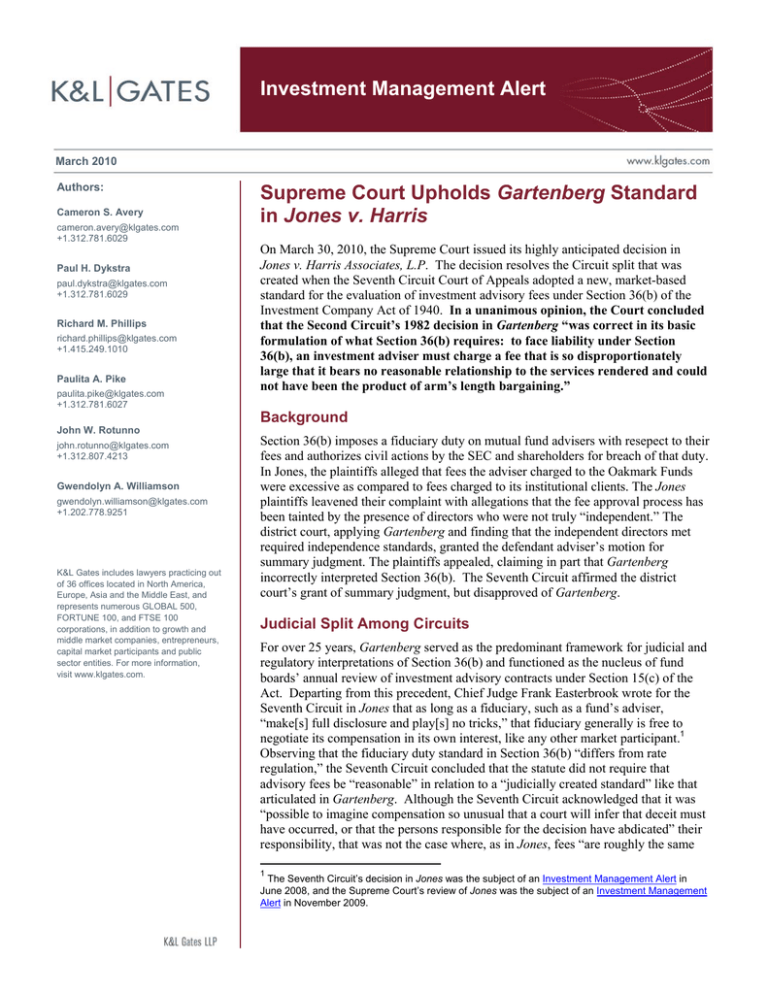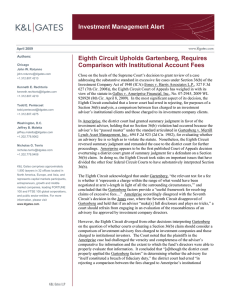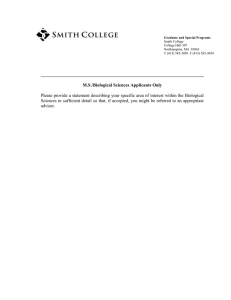
Investment Management Alert
March 2010
Authors:
Cameron S. Avery
cameron.avery@klgates.com
+1.312.781.6029
Paul H. Dykstra
paul.dykstra@klgates.com
+1.312.781.6029
Richard M. Phillips
richard.phillips@klgates.com
+1.415.249.1010
Paulita A. Pike
paulita.pike@klgates.com
+1.312.781.6027
Supreme Court Upholds Gartenberg Standard
in Jones v. Harris
On March 30, 2010, the Supreme Court issued its highly anticipated decision in
Jones v. Harris Associates, L.P. The decision resolves the Circuit split that was
created when the Seventh Circuit Court of Appeals adopted a new, market-based
standard for the evaluation of investment advisory fees under Section 36(b) of the
Investment Company Act of 1940. In a unanimous opinion, the Court concluded
that the Second Circuit’s 1982 decision in Gartenberg “was correct in its basic
formulation of what Section 36(b) requires: to face liability under Section
36(b), an investment adviser must charge a fee that is so disproportionately
large that it bears no reasonable relationship to the services rendered and could
not have been the product of arm’s length bargaining.”
Background
John W. Rotunno
john.rotunno@klgates.com
+1.312.807.4213
Gwendolyn A. Williamson
gwendolyn.williamson@klgates.com
+1.202.778.9251
K&L Gates includes lawyers practicing out
of 36 offices located in North America,
Europe, Asia and the Middle East, and
represents numerous GLOBAL 500,
FORTUNE 100, and FTSE 100
corporations, in addition to growth and
middle market companies, entrepreneurs,
capital market participants and public
sector entities. For more information,
visit www.klgates.com.
Section 36(b) imposes a fiduciary duty on mutual fund advisers with resepect to their
fees and authorizes civil actions by the SEC and shareholders for breach of that duty.
In Jones, the plaintiffs alleged that fees the adviser charged to the Oakmark Funds
were excessive as compared to fees charged to its institutional clients. The Jones
plaintiffs leavened their complaint with allegations that the fee approval process has
been tainted by the presence of directors who were not truly “independent.” The
district court, applying Gartenberg and finding that the independent directors met
required independence standards, granted the defendant adviser’s motion for
summary judgment. The plaintiffs appealed, claiming in part that Gartenberg
incorrectly interpreted Section 36(b). The Seventh Circuit affirmed the district
court’s grant of summary judgment, but disapproved of Gartenberg.
Judicial Split Among Circuits
For over 25 years, Gartenberg served as the predominant framework for judicial and
regulatory interpretations of Section 36(b) and functioned as the nucleus of fund
boards’ annual review of investment advisory contracts under Section 15(c) of the
Act. Departing from this precedent, Chief Judge Frank Easterbrook wrote for the
Seventh Circuit in Jones that as long as a fiduciary, such as a fund’s adviser,
“make[s] full disclosure and play[s] no tricks,” that fiduciary generally is free to
negotiate its compensation in its own interest, like any other market participant.1
Observing that the fiduciary duty standard in Section 36(b) “differs from rate
regulation,” the Seventh Circuit concluded that the statute did not require that
advisory fees be “reasonable” in relation to a “judicially created standard” like that
articulated in Gartenberg. Although the Seventh Circuit acknowledged that it was
“possible to imagine compensation so unusual that a court will infer that deceit must
have occurred, or that the persons responsible for the decision have abdicated” their
responsibility, that was not the case where, as in Jones, fees “are roughly the same
1
The Seventh Circuit’s decision in Jones was the subject of an Investment Management Alert in
June 2008, and the Supreme Court’s review of Jones was the subject of an Investment Management
Alert in November 2009.
Investment Management Alert
. . .as those that other funds of similar size and
investment goals pay their advisers. . . .” The
Circuit split created by Jones caused Judge Richard
Posner, in a vigorous dissent from the denial of
rehearing by the full Seventh Circuit, to question the
substantive standard required by Section 36(b).
According to Judge Posner, the “economic analysis”
underlying the panel decision’s rejection of
Gartenberg was “ripe for reexamination” not only
because it created a Circuit split but because of the
“importance of the issue to the mutual fund
industry.” Oral arguments, heard by the Supreme
Court in early November 2009, focused on the
nature of the fiduciary duty under Section 36(b); the
appropriate standard for measuring advisory fees
and the appropriateness of institutional versus retail
advisory fee comparisons in Section 36(b) inquiries;
and the roles of fund boards and courts in Section
36(b) cases.2
The Supreme Court Weighs In
In its Jones opinion, which vacates the Seventh
Circuit’s decision, the Supreme Court embraced the
Gartenberg standard as the correct approach in the
review of challenged advisory fees. The
Gartenberg framework, Justice Alito wrote for
the unanimous Court, accurately reflects the
“delicate compromise” between shareholder and
adviser interests that Congress “embedded in
§36(b).” The Court recognized that “while the
standard for an investment adviser’s fiduciary duty
has remained an open question in our Court . . . until
the Seventh Circuit’s decision below, something of a
consensus had developed regarding the standard set
forth 25 years ago in Gartenberg.” The Court’s
opinion also noted that Gartenberg “has been
adopted by other federal courts, and ‘the SEC’s
regulations have recognized, and formalized,
Gartenberg-like factors’.”
On Advisers’ Fiduciary Duty
A significant portion of the Court’s opinion is
dedicated to an exploration of the history of Section
2
Subsequent to the Seventh Circuit’s ruling in Jones, and prior
to the Supreme Court argument in that case, the Eighth Circuit
held in Gallus v. Ameriprise Financial Inc., that it was error for
a district court to reject a comparison of the fees charged by
an investment adviser to its institutional and retail clients. The
Ameriprise decision was the subject of an Investment
Management Alert in April 2009.
36(b), which was adopted by Congress in 1970,
with the goal of illuminating the meaning of the
statutory statement that an investment adviser “shall
be deemed to have a fiduciary duty with respect to
the receipt of compensation for services.”
Observing that the meaning of Section 36(b) “is
hardly pellucid,” the Court affirmed that the
Gartenberg formulation “was correct.” Citing its
1939 decision in Pepper v. Litton, the Supreme
Court stated that “the essence of the test [as to
whether a fiduciary duty has been violated] is
whether or not under all the circumstances the
transaction carries the earmarks of an arm’s length
bargain.” According to the Court, “[t]he
Gartenberg approach fully incorporates this
understanding of the fiduciary duty . . . Gartenberg
insists that all relevant circumstances be taken into
account . . . .” The Court also highlighted that
“[t]he Investment Company Act shifts the burden of
proof from the fiduciary to the party claiming
breach,” thus emphasizing that plaintiffs (and not
investment advisers) continue to have the burden of
proof when bringing suit under Section 36(b), as
acknowledged in Gartenberg.
On Comparative Fees
The Court reviewed extensively the role of
comparative fees in the Section 36(b) calculus.
Commenting on the usefulness of comparing a
mutual fund’s advisory fees to the fees charged by
the fund’s adviser to other clients, the Court
reasoned that “[s]ince the Act requires consideration
of all relevant factors . . . we do not think that there
can be any categorical rule regarding the
comparisons of the fees charged different types of
clients. Instead, courts may give such comparisons
the weight that they merit in light of the similarities
and differences between the services that the clients
in question require.” Warning against “inapt
comparisons,” the Court noted that:
there may be significant differences
between the services provided by an
investment adviser to a mutual fund and
those it provides to a pension fund which
are attributable to the greater frequency of
shareholder redemptions in a mutual fund,
the higher turnover of mutual fund assets,
the more burdensome regulatory and legal
obligations, and the higher marketing costs.
If the services rendered are sufficiently
March 2010
2
Investment Management Alert
different that a comparison is not probative,
then courts must reject such a comparison.
Even if the services provided and the fees
charged to an independent fund are relevant,
courts should be mindful that the Act does
not necessarily ensure fee parity between
mutual funds and institutional clients
contrary to petitioners’ [plaintiffs’]
contentions.
The Court also warned, as did the Gartenberg court,
against placing too much emphasis on a comparison
of one fund’s advisory fees against fees charged to
other mutual funds by other advisers. “These
comparisons are problematic because these fees, like
those challenged, may not be the product of
negotiations conducted at arm’s length.” Moreover,
the Court cited Gartenberg for the proposition that
“competition between . . . funds for shareholder
business does not support an inference that
competition must therefore also exist between
[investment advisers] for fund business. The former
may be vigorous even though the latter is virtually
non-existent.”
The Court’s reference to marketing costs as a
differentiating factor between advisory services
charged to mutual funds and institutional investors
such as pension funds may affect how directors
assess advisory fees in their annual Section 15(c)
contract renewal process. This recognition of
marketing costs may prove to be especially
significant as it could undermine the SEC’s longheld position that the fund directors should not
consider such costs in evaluating mutual fund
advisory fees.
On the Role of Independent Directors
The Court’s opinion appears to be a major
affirmation of the crucial role of informed and
diligent fund directors in overseeing fees and
monitoring conflicts of interest. Citing Burks v.
Lasker, a case decided by the Court in 1979, the
Court observed that “[u]nder the Act, scrutiny of
investment adviser compensation by a fully
informed mutual fund board is the ‘cornerstone of
the . . . effort to control conflicts of interest within
mutual funds’ . . . The Act interposes disinterested
directors as ‘independent watchdogs’ of the
relationship between a mutual fund and its adviser.”
The Court also acknowledged that the Act “instructs
courts to give board approval of an adviser’s
compensation ‘such consideration . . . as is deemed
appropriate under all the circumstances.’” The
Court noted that from “this formulation, two
inferences may be drawn. First, a measure of
deference to a board’s judgment may be appropriate
in some instances. Second, the appropriate measure
of deference varies depending on the
circumstances.” According to the Court,
“Gartenberg heeds these precepts. Gartenberg
advises that ‘the expertise of the independent
trustees of a fund, whether they are fully informed
about all facts bearing on the [investment adviser’s]
service and fee, and the extent of care and
conscientiousness with which they perform their
duties are important factors to be considered in
deciding whether they and the [investment adviser]
are guilty of a breach of fiduciary duty . . . .’”
On the Role of Judicial Review of
Board Decisions
The Jones opinion focused on the dangers
associated with judicial review of a board’s decision
regarding advisory fees. The Court stressed that
“where a board’s process for negotiating and
reviewing investment-adviser compensation is
robust, a reviewing court should afford
commensurate deference to the outcome of the
bargaining process. Thus, if the disinterested
directors considered the relevant factors, their
decision to approve a particular fee agreement is
entitled to considerable weight, even if a court
might weigh the factors differently.” The Court
also considered the possibility that “a fee may be
excessive even if it was negotiated by a board in
possession of all relevant information.” In those
instances, according to the Court, “a determination
[by a court] must be based on evidence that the fee
‘is so disproportionately large that it bears no
reasonable relationship to the services rendered and
could not have been the product of arm’s length
bargaining.’” Addressing a scenario in which “the
board’s process was deficient or the adviser
withheld important information,” the Court stated
that judicial review of the board’s decision must be
more “rigorous.” In any case, the Court stressed
that “Section 36(b) does not call for judicial secondguessing of informed board decisions.”
March 2010
3
Investment Management Alert
Conclusion
The Court concluded its opinion by once more
endorsing the principles articulated in Gartenberg.
Noting that the “Gartenberg standard, which the
[Seventh Circuit] panel rejected, may lack sharp
analytical clarity,” the Court emphasized that
“we believe that it accurately reflects the
compromise that is embodied in Section 36(b),
and it has provided a workable standard for
nearly three decades. The debate between the
Seventh Circuit panel and the dissent [in that
Circuit] . . . regarding today’s mutual fund market is
a matter for Congress, not the courts.”
Anchorage Austin Beijing Berlin Boston Charlotte Chicago Dallas Dubai Fort Worth Frankfurt Harrisburg Hong Kong London
Los Angeles Miami Moscow Newark New York Orange County Palo Alto Paris Pittsburgh Portland Raleigh Research Triangle Park
San Diego San Francisco Seattle Shanghai Singapore Spokane/Coeur d’Alene Taipei Tokyo Warsaw
Washington, D.C.
K&L Gates includes lawyers practicing out of 36 offices located in North America, Europe, Asia and the Middle East, and represents numerous
GLOBAL 500, FORTUNE 100, and FTSE 100 corporations, in addition to growth and middle market companies, entrepreneurs, capital market
participants and public sector entities. For more information, visit www.klgates.com.
K&L Gates is comprised of multiple affiliated entities: a limited liability partnership with the full name K&L Gates LLP qualified in Delaware and
maintaining offices throughout the United States, in Berlin and Frankfurt, Germany, in Beijing (K&L Gates LLP Beijing Representative Office), in
Dubai, U.A.E., in Shanghai (K&L Gates LLP Shanghai Representative Office), in Tokyo, and in Singapore; a limited liability partnership (also named
K&L Gates LLP) incorporated in England and maintaining offices in London and Paris; a Taiwan general partnership (K&L Gates) maintaining an
office in Taipei; a Hong Kong general partnership (K&L Gates, Solicitors) maintaining an office in Hong Kong; a Polish limited partnership (K&L
Gates Jamka sp. k.) maintaining an office in Warsaw; and a Delaware limited liability company (K&L Gates Holdings, LLC) maintaining an office in
Moscow. K&L Gates maintains appropriate registrations in the jurisdictions in which its offices are located. A list of the partners or members in each
entity is available for inspection at any K&L Gates office.
This publication is for informational purposes and does not contain or convey legal advice. The information herein should not be used or relied upon
in regard to any particular facts or circumstances without first consulting a lawyer.
©2010 K&L Gates LLP. All Rights Reserved.
March 2010
4








